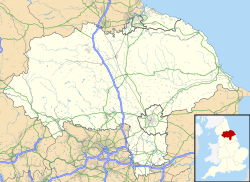History
The "Little" North Western Railway's Ingleton station was originally opened in 1849 as a temporary terminus, but closed only ten months later as the company could not afford to continue the line beyond Ingleton. [1]
Eventually it was the Lancaster and Carlisle Railway (L&CR) that built the Ingleton Branch Line from the existing Ingleton Station to Low Gill. [2] By the time the branch was completed in 1861, the L&CR was operated by the London and North Western Railway (L&NWR), and the NWR was operated by the rival Midland Railway (MR), and the L&NWR did everything in its power to frustrate the MR's ambition of using the new line as a main route to Scotland. Thus the L&NWR built Ingleton (L&NW) station at the other end of Ingleton Viaduct. The Ingleton Branch, and the L&NW station, opened on 16 September 1861. [3] The MR reopened the original Ingleton station two weeks later but refused to let L&NW trains use it. [4] Passengers had to walk a distance of almost 1 mile (1.6 km) between the two Ingleton stations, descending into the valley below and climbing up the other side, where they often had a long wait as the companies did not cooperate over timetabling either. [5] By 1862, the MR agreed to allow L&NW trains to terminate at the Midland station, but both Ingleton stations remained open and connections were not timetabled. [6]
On the positive side, the presence of two stations allowed people to pay a penny fare to cross the viaduct between the two stations simply to enjoy the view. [7]
On 13 March 1893, a 1-mile (2 km) mineral line was opened from the L&NW station to Meal Bank Quarry. It passed over a high embankment and bridge across the entrance to the Ingleton Waterfalls Trail. The embankment survives to this day. The quarry and its line closed in 1909. [8]
The L&NW station closed on 1 January 1917. [3] The other station survived until the line's closure in 1954. The L&NW station was demolished and the site is now used by a fuel supplier.
This page is based on this
Wikipedia article Text is available under the
CC BY-SA 4.0 license; additional terms may apply.
Images, videos and audio are available under their respective licenses.
